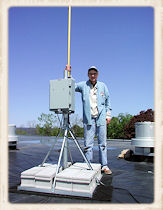
 |
| Out-of-Site Info Station Near Palmito Ranch Battlefield with a Broadcast Range of 25-75 Square Miles |
| Are you aware that the last battle of the American Civil War was fought after the Confederate Army had officially surrendered? It was not fought in Georgia or Virginia but on a Texas Ranch just miles from the Mexican border. And, it was won by not the Union Army but by the Confederates! The Battle of Palmito Ranch is an the intriguing narrative, yet thousands of motorists pass within yards of the site every day at 65 miles per hour, never recognizing its existence. To rectify this, in 2011 an Information Radio Station was installed at the historic spot by the Texas Historical Commission. The station, which broadcasts on AM frequency 1610, tells motorists on nearby Boca Chica Highway how to find the battlefield and of its importance in American history. Since there is little to see today at the battlefield site, the broadcast program is especially important – designed to paint a picture of the battle – allowing listeners to imagine it right in their cars even if a disability prevents them from walking the site. "Hearing the stories of those who came before us puts people in a perfect frame of mind to consider their cultural heritage and the importance of preserving it for future generations," comments William McWhorter, then military sites program coordinator with the Texas Historical Commission. As America approached the Sesquicentennial of the Civil War, one of the THC’s goals was, according to MWhorter, "to continue its efforts of enhancing interpretation and preservation efforts at Palmito Ranch Battlefield National Historic Landmark." The station was also intended to be used to describe area wildlife that visitors can observe, and to alert them to the presence of traffic stops and safety issues that might affect their visits. |
 |
| Robert Sperling of SPLKA stands by "Light Talk 1610." |
| The best way to get visitors interested in what a historic site has to offer is to give them a sample. That’s what an Information Radio Station can do. The stations have become our nation’s 24/7 story-tellers, encouraging passers-by to visit, all the while informing them about directions, hours of operation and special events. |
 |
| Big Sable Point Lighthouse in Ludington, Michigan Photo by Linda Folland |
| Sable Point Lighthouse Keepers Association (in association with the City of Ludington, Michigan) operates “Light Talk 1610” to help visitors find and appreciate three historic lighthouses on the Lake Michigan Shore. The creative broadcast features interviews with volunteer lighthouse keepers, descriptions of the different lights, directions to reach them, hours of operation and dates of special events. |
| * * * |
| In Spring Hill, Tennessee, the Maury County Convention and Visitors Bureau in Central Tennessee has operated an Information Station for many years in conjunction with Rippavilla Plantation to interpret the site and encourage visitors to stop in. The Plantation was built by a family of French descent just before the Civil War and served as a gathering place for Confederate generals prior to the Battle of Franklin. Area visitors hear the story of the plantation, learn about tours and upcoming special events by tuning to AM 1610. |
 |
| InfOspot is a FCC-certified professional, license-free radio station and the most affordable solution for local area broadcasting. |
| Information Stations discussed in these articles traditionally have a range of 3-5 miles. But the InfOspot Radio Station offers a reception distance more suitable for on-premise applications (approx ¼ mile) at approximately ¼ the price. Requiring no FCC license, InfOspot systems are frequently installed at unstaffed historic locations to provide interpretation to visitors in their vehicles who are in position to view the site while they listen. InfOspot technology is in use at Zane Grey House (Upper Delaware Scenic and Recreational River), Montana Department of Fish, Wildlife and Parks; US Fish and Wildlife Refuge - Crab Orchard Wildlife Refuge in Illinois and Cleveland Metroparks in Ohio. Nez Perce National Historical Park in Idaho has operated an InfOspot system since 2007 and added two more locations that spring to interpret sites “whose isolation and absence of visitor services pose particular management challenges,” according to NPS’ Scott Eckberg. He went on to mention that the Park’s transmitter “had operated for years without interruption, in all weather. The Park's confidence in the system led to expanding it to the two other locations. Eckberg further stated, "This technology bridges a communication gap between the Park and its visitors.” |
© 1983-2025 • Information Station Specialists • All Rights Reserved
PO Box 51, Zeeland, Michigan, USA, 49464-0051, Phone 616.772.2300, Email
• • •